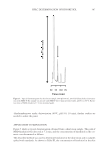COMPATIBILITY STUDIES IN BINARY MIXTURES OF AVOBENZONE 319 drug is compared with that of the drug–excipient mixture and of the pure excipient. Disappearance of an absorption peak or reduction of the peak intensity combined with the appearance of new peaks gives a clear evidence for interaction between the excipient and the drug investigated. Butyl methoxydibenzoylmethane (Avobenzone) (Figure 1) has strong absorption in the UVA1 range (λ maximum at 380 nm). Although it is a broad-spectrum UVA fi lter, the compound is photolabile and can be rapidly oxidized, and its oxidation will inactivate the antioxidant systems. Unfortunately, it has been shown that its photoprotective capacity decreases by 50% to 60% after 1 h of exposure to sunlight (35). Because of its instability, it is necessary to formulate the avobenzone with compatible excipients. MATERIALS AND METHODS MATERIALS AND REAGENTS Avobenzone was received as a gift sample from Merck Química Argentina (Merck, Darmastadt, Germany). Following chemicals and excipients were purchased from com- mercial sources and used as such: ascorbyl palmitate (Hoffmann La Roche, Basel, Switzerland) butylated hydroxytoluene (BHT) (Eastman Chemical Company, Kingsport, TN) silicone fl uid (Dow Corning, Campinas, Brazil) paraffi num liquidum (R.A.A.M., Buenos Aires, Argentina) acetylated lanolin (Acelan L, Fabriquímica, Buenos Aires, Argentina) cetearyl alcohol/sodium lauryl sulfate/sodium cetearyl sulfate (Flamacer SX, Flamaquímica, Buenos Aires, Argentina) methyl p-hydroxybenzoate, propyl p-hydroxybenzoate (Clariant, Aberdeen, United Kingdom) propylene glycol (Dow Chemical, Midland, MI) imidaz- olidinyl urea (Biofl ama 115, Flamaquímica) sorbitol 70% (water solution), (Unión Química Argentina, Buenos Aires Argentina) cetearyl alcohol (Flamaquímica) glycerin (Flamaquímica) disodium EDTA (Merck, Darmstadt, Germany) caprylic capric triglyc- eride (Flamacer CC, Flamaquímica) titanium dioxide/silica (Eusolex T-AVO, Merck), and diethylhexyl syringylidene malonate (Oxynex ST, Merck). DIFFERENTIAL SCANNING CALORIMETRY A differential scanning calorimeter (DSC 822, Mettler Toledo, Greifensee, Switzerland) was used for thermal analysis of drug and excipients. Excipients that were expected to be used in the development of a formulation (preservatives, surfactants, oil phase, aque- ous phase, and antioxidants) and the maximum expected ratio were selected for this Figure 1. Avobenzone.
JOURNAL OF COSMETIC SCIENCE 320 study. Individual samples (drug and excipients) as well as physical mixtures of the drug and selected excipients were weighed directly in the pierced DSC aluminum pan and scanned in the temperature range of 25–400°C under atmosphere of dry nitrogen. A heating rate of 10°C/min was used and the obtained thermograms were observed for any interaction. The DSC cell was calibrated with indium (m.p. 156.6°C ΔHfus = 28.5 J/g) and zinc (m.p. 419.6°C) as standards. ISOTHERMAL STRESS TESTING For IST studies, the active and different excipients were weighed directly in 5-ml glass vials (n = 2) and mixed on a vortex mixer for 2 minutes. In each of the vials, the active– excipient blend was further mixed with a sealed glass capillary. To prevent any loss of material, capillary was broken and left inside the vial. Each vial was sealed using a Tefl on- lined screw cap and stored at 50°C (Hot air oven, Ionomex, Buenos Aires, Argentina). These samples were periodically examined for any unusual color change. After 15 days of storage at the above conditions, samples were quantitatively analyzed using HPLC. For sample preparation, an amount of powder equivalent to 50 mg of avobenzone was taken in a 100-ml volumetric fl ask, dissolved in 60 ml of methanol, stirred for about 5 min, and then diluted to volume with methanol. A 1-ml aliquot of the solution was trans- ferred to a 50-ml volumetric fl ask. The sample was diluted to volume with methanol. For standard preparation, 25 mg of avobenzone was taken in a 50-ml volumetric fl ask, dissolved in 20 ml of methanol, stirred for about 5 min, and then diluted to volume with methanol. A 1-ml aliquot of the solution was transferred to a 50-ml volumetric fl ask. The sample was diluted to volume with methanol. For the analysis of active–excipient mixtures, an HPLC system equipped with a dual piston reciprocating Spectra Physics pump (Model ISO Chrom. LC pump, Irvine, CA), a UV-Vis Hewlett Packard detector (Model 1050), a Hewlett Packard integrator (Series 3395, Loveland, CO), and a Rheodyne injector (Model 7125) were used. Chromato- graphic quantifi cation of lipoic acid was performed on a Microsorb-MV® 100 Å C18 (5 μm) Varian Analytical Instruments (Walnut Creek, CA). The mobile phase used was methanol:water (95:5, v/v) (pH 3.2) adjusted with 85% of phosphoric acid. Separation was isocratically carried out at room temperature the fl ow rate was 1.0 ml/min, with UV detection at 315 nm. The volume of each injection was 20 μl. Before injecting solutions, the column was stabilized for at least 30 min with the mobile phase fl owing through the system. Quantifi cation was accomplished using an external standard method. In the external standard method, the solute chosen as the reference is chromatographed separately from the sample. However, results from two chromatograms will be compared, so chromatographic conditions must be maintained extremely constant. Each solution was prepared in dupli- cate and was injected in triplicate, and the relative standard deviation was below 2.0%. IR SPECTROSCOPY IR spectra of active and active–excipient blends were recorded on an IR spectrophotom- eter Perking Elmer FT-IR Spectrum One (Shelton, CT), in the range of 4000–450 cm-1. Solid and liquid samples were analyzed using nujol suspensions.
Purchased for the exclusive use of nofirst nolast (unknown) From: SCC Media Library & Resource Center (library.scconline.org)





















































































